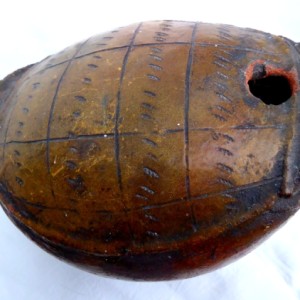From my father's collection: Fijian pots
When my father, and then my mother, died when I was in my mid-twenties I inherited all his things. He was a collector of tribal art and artifacts. This is a sensitive topic today and rightly so, because much of the stuff that was brought home by travellers, traders, soldiers, sailors, missionaries and colonial administrators had been stolen, looted or unfairly obtained.
Luckily I don't have to carry that burden of guilt in a personal way since my father was only ever a secondary collector. Although he studied anthropology he never had the opportunity to travel beyond Europe. Instead he haunted junk shops, bric-a-brac stalls and curio sellers, from his youth and throughout the rest of his life. We often had to stop the car because he had spotted a shabby sign for "Antiques" and he would gleefully emerge 10 minutes later bearing an item he had instantly recognised - the shop keeper having no idea. (That's changed now because by using an image search it's possibly to identify unfamiliar objects with a few key strokes.) My father's mind was a compendium of abstruse knowledge about curious and obscure material from other cultures and this was how he came by these things. It wasn't just a hobby or mania for collection. He admired and respected the beauty to be found in the art and artifacts of other cultures, whether simple or sophisticated.
Now my problem is that I have so much. I could blip something different every day for a year. My lockdown task is to try and move on as many of these items as I can - not for money but in the hope that they can be , if not 'sent home', at least placed in ethically and culturally acceptable museums or public collections. (I did in fact repatriate a large Ethiopian painting several years ago and it now resides in the Addis Ababa museum where a kind blipper found it and took a photo for me.)
The object pictured, and its companion (extra) came, I think, from an early Oxfam shop before charities realised that some of the stuff they were being given might have intrinsic value that was not immediately obvious to the volunteers who received it. These are Fijian pottery water containers. The main picture shows a saqa moli. There's a very similar one in the Horniman museum in London described thus
"Pottery water vessel in the form a bunch of grapefruits, with four [5 in my one] interconnecting spherical chambers and two spouts for pouring both forwards and backwards. The pot has been partially glazed with a tree resin and is gouged with a knife."
See here.
The other is called a saqa vonu and is shaped like a turtle. There's one just like it in a museum in Auckland, NZ. See here
Who knows how they came to be in a charity shop? Presumably a clear out after someone's death. Unlike most of my father's collection these pots do have a provenance because along with them was a crumbled card with some faded writing, mostly illegible but possible to read that they dated from 1850-80 and that they were [similar to?] the pots displayed at the British Empire Exhibition in 1923.
Traditional Fijian pottery is still made today. The techniques was originally brought by outsiders who arrived by sea 30,000 years ago.
There's short piece about the modern version here and a longer description of Fijian pottery making here including photos of an especially skilled mistress of the craft.
Or, there's a short video which shows Fijian women mixing clay with their feet before making it into pots. A world away from chilly, miserable Europe!


Comments
Sign in or get an account to comment.


